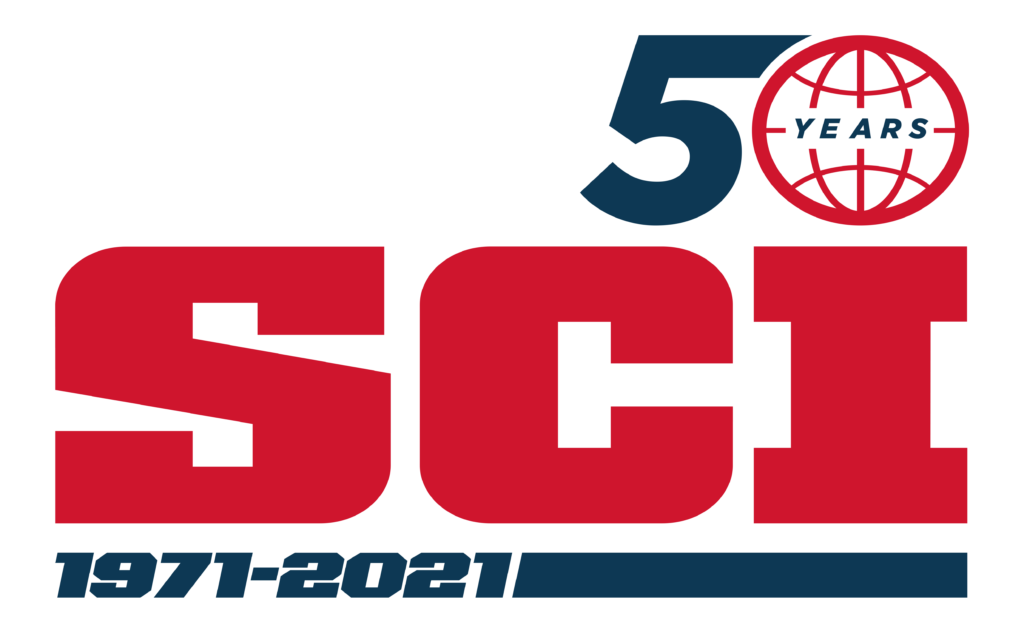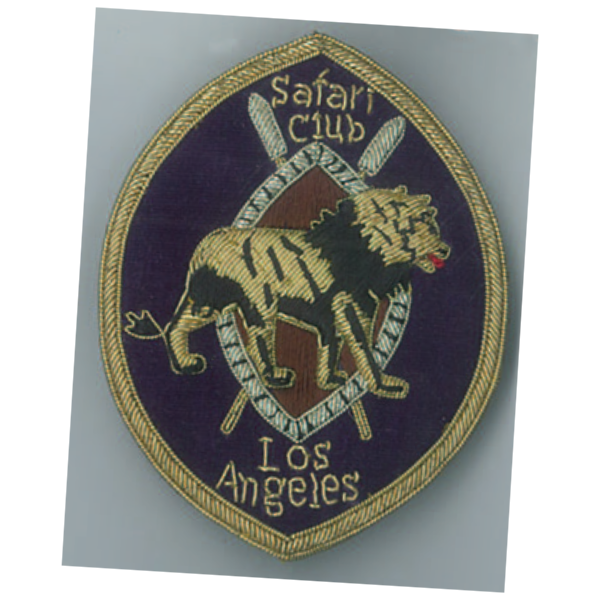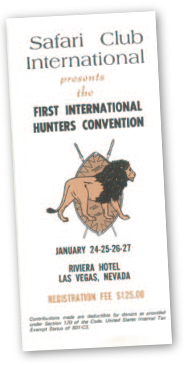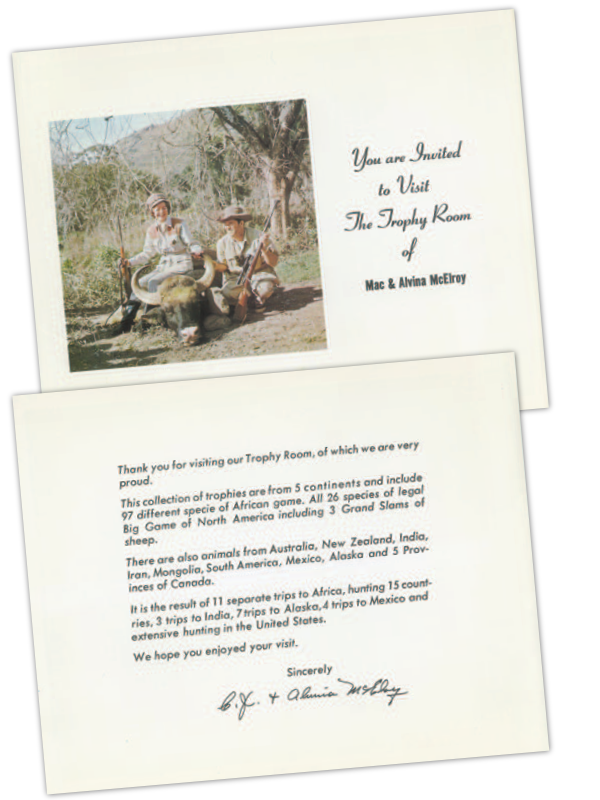In The Beginning: The Genesis Of SCI And Who Was There

Editor’s note: This year we are gearing up for SCI’s 50th Anniversary, which will be celebrated at the Convention in Las Vegas January 19-22, 2022 with a party, the likes of which we’ve never seen before.. In an actually not-so-odd turn of events, SCI has a chapter that is older than the mother organization itself. That’s because SCI evolved out of what we now know as the Los Angeles Chapter. Chronologically, Safari Club of Los Angeles (which became the Los Angeles Chapter) was formed in 1971, SCI itself was formed in 1972 and the first convention was held in 1973.
With that in mind, we present here some of the recollections of two of the founders, who along with a couple of others of the originals, plan to be at the Convention this year. They have provided a wealth of memorabilia to share here, including some of the founding documents and other items that show we are who we are at SCI because of what we were in the beginning. The passion for hunting remains alive and well.
This article is a reprint from SAFARI Magazine JF11/Page 12 and appears in the March/April 2021 edition to commemorate 50 Years of SCI.
by Dr. Leroy C. Trnavsky
It was July of 1960. I was still a starving student working in Chet and Chris Wiegle’s mama/papa type sporting goods store in South Central Los Angeles, on the corner of 89th and Western Avenue.
I had just finished all of my clinical rotations at the University of Southern California School of Dentistry, and was awaiting the results of my state board examination.
I was back in the gun department when a short, muscular gentleman with black wavy hair walked up to the counter where Chet was standing. I had seen him in the store on several occasions.
He pulled a small packet of 3 1/2 x 5-inch colored photos out of his pocket and showed them to Chet, who called me over to see them. He introduced me to C.J. “Mac” McElroy, who had just returned from his first African safari.
It had been a 30-day safari in Kenya with White Hunters (Africa) Ltd, during which Mac was able to collect the Big Five, and as far as I ever knew, that handful of small color photos was all he had to document that hunt. He had hunted on a 2×1 safari with his old hunting partner, a Mr. Lee Williams.
He told me what it would be like and how to do it. “When you make that trip,” Mac said, “go 1×1 so that everything you see will be your shot if you want it. You go too far, pay too much money and work too hard not to have the shot when you find your game.” That was Mac.
Mac later wrote and published a small 5 ½ x 8 ¼- inch, 77-page book about that hunt titled “African Safari of an Amateur Hunter,” that sold for $1.98 in Chet’s sporting goods store. I purchased two copies that I had Mac sign. In retrospect, I should have purchased a dozen.
During the remainder of the 1960s, I occasionally ran into Mac at Weigle’s. At one of these meetings in 1968, Mac mentioned that the Southern California Safari Club was having its awards banquet and asked if I wanted to go. I said yes.
A few days later, I received a phone call from Hal Meeker, a good friend and hunting partner of Mac’s. Shortly thereafter, my business partner and lifelong friend, Dr. Ben Robson, received an invitation to attend the function, which was being held in Beverly Hills.
During the evening, Hal and Mac asked Ben and me to become members of the Southern California Safari Club. At that time, to be eligible, you either had to have hunted Africa or Alaska, or have an actual hunt booked in either place.
Ben and I had decided we were going to book a hunt in Alaska, and both Mac and Hal Meeker recommended Denny Thompson.
We later booked a 28-day hunt with Denny for the fall of 1968, but we were too busy at that time to join the Southern California Safari Club. The club held meetings at lunch in the Hollywood area, which would have meant an entire day out of the office for both of us.
After the 1968 awards banquet, both Ben and I began hunting regularly.
Early in 1971, we received a call from Tom Radoumis, our taxidermist and owner of De Jon’s Taxidermy in Rosemead, California. Mac had become disenchanted with the Southern California Safari Club and decided to start his own club. He asked Tom, also his taxidermist, if he would survey clients to see if any were interested in becoming members of a new safari club. My business partner and I decided to become even more active in hunting, about which we felt so strongly.
Tom relayed our positive feelings to Mac, and he invited us and others to meet at his business on Locust Street in Inglewood, California.
This meeting turned out to be a fundraiser to start Safari Club. Shortly after that, letters and applications were mailed to hunters all over Southern California, inviting them to join the new Los Angeles Safari Club.
Over the next few weeks, Tom Radoumis was responsible for 55 new members joining. There were no requirements as to what or where you had hunted.
The first meeting of the new Los Angeles Safari Club was a luncheon on Wednesday, April 7, 1971 at McHenry’s Tail Of The Cock restaurant on La Cienega Boulevard in Los Angeles, with 47 members present. Meetings were held on the second Wednesday of each month at 7 p.m.
In September of 1971, the first issue of SAFARI Magazine was printed with a run of only 200 copies. It featured Mac on the cover with a fine oryx. Cover-to-cover, it contained only 24 pages.
These quickly disappeared and Mac had an additional 800 copies run, which were sold for 50 cents a copy. Again, I should have purchased a dozen copies.
This first issue was followed by one in the spring of 1972, winter of 1972 (a very rare copy if you can find one), spring of 1973 and winter of 1973, by which time it had grown to 40 pages.
In September of 1971 our lion logo was registered as the trademark for the Los Angeles Safari Club’s exclusive use. The designer of the logo was a chapter member, artist, hunter and personal friend of Mac’s by the name of William “Bill” Yates, who lived in Van Nuys, California.

The emblem/badge was manufactured for the club by Gold Crest Ltd., located on Ventura Boulevard in Studio City, California, using actual gold and silver threads. Mac only wanted the best for our new club. It cost about $75.
Bill Yates later painted a portrait of Mac that was presented to the club at our first annual awards banquet on June 9, 1972 at the Beverly Wilshire Hotel in Beverly Hills, California. This affair marked our first successful year as a big game hunting club.
A little later that same year, after a short legal skirmish with the Shikar Safari Club International that claimed infringement on their name, Safari Club International prevailed and was incorporated as a 501(c)(3) organization.
At the same time all of the above was occurring, William Phifer developed a club roster. The roster included a picture of each member, listing his personal statistics and a history of his past hunts and accomplishments in the hunting world.
These individual pages were housed in a small 6 x 8-inch, six-ringed notebook that was gold embossed with the club logo and the owner’s name on the front cover. It finally ended up costing $65. It also listed those individuals who were considered “Charter Members” and that was also embossed on the front cover, but it did not delineate those who could and should be considered “founding members.”
This has led to some confusion through the years as to who was actually present at the genesis of what has become SCI. Charter members were first designated as those entering membership by May 21, 1971 and later extended to June 21, 1971, but there never was a designation regarding those members who were there before there was an official organization.
With Mac’s energy, leadership and his innate ability to pick the right individual for the job, the club grew rapidly during the first year, with new members being admitted at each meeting. Among these new members were some of the biggest names in the hunting world such as Elgin Gates and Roy Weatherby.
On March 4, 1972, just prior to the actual name change from the Los Angeles Safari Club to Safari Club International, Mac invited all interested members to stop by his trophy room for a few cocktails and a social get-together.
The main reason for this get-together was to present a non-profit foundation. He and member Robert “Bob” Elder called it the “Hunters Hall of Fame.” Mac felt that if baseball, football and cowboys can have a Hall of Fame, certainly hunters, which represent the oldest sport of all, should also have a Hall of Fame.
Many checks were written to help finance the project, but four of them from members Dr. Ed Chatwell, Don Miller, Bruno Scherrer and George Isaacs were given special recognition because of their generosity.

In early 1972 an out-of-town member from the Chicago area by the name of Roman Hupalowski, a well known booking agent with a great hunting resumé of his own, was at the meeting. That evening, members approved expanding the club to include other chapters. Shortly thereafter Mac made a trip to Chicago to confer with a group of hunters Roman brought together, using his agency’s mailing list of clients.
As I recall, one or two other members of the chapter, possibly including Dr. Loren Lutz, accompanied Mac. The group Roman invited received Mac enthusiastically and Chicago became the second chapter in what was to be quickly renamed Safari Club International.
Mac returned to let the members know what had happened in Chicago, and two things occurred at the regular meeting on March 9, 1972. The name of “The Los Angeles Safari Club” was changed to “Safari Club International” and Dr. Loren Lutz immediately made a motion that the Safari Club of Los Angeles should become the first and founding chapter of the new Safari Club International. The motion was seconded by Donald Carper and was passed by a unanimous vote of more than 80 members present.
A few months later in September 1972, chapter member and attorney A.L. Hamilton, Chairman of the Legal Committee, filed the necessary documents with the state to reflect the new name, Safari Club International, Los Angeles Chapter.
Chicago became the second chapter and the rest is history. Multiple new chapters were chartered in 1972 as a result of a special membership committee, which made numerous trips throughout the country to enlist new chapters.
While the logo design, trademark registrations, corporation filings, membership roster, club bylaws, committee assignments, guest speakers, entertainment nights, Hunters Hall of Fame Foundation and the morphing of the Los Angeles Safari Club into Safari Club International were being accomplished, there was one other major endeavor in our first year – the first International Hunters Conference, as it was called then. It was held at the Riviera Hotel in Las Vegas, Nevada, starting on January 24, 1973 and culminating on Saturday, January 27 with a banquet dinner in the Grand Ballroom that saw the installation of the first of the world’s great hunters into the Hunters Hall of Fame.

The total fee for all four days of the convention was $125 and four nights at the Riviera Hotel was $110, including tax. Mac handled all the paperwork at his business in Inglewood, including the hotel reserva tions. Mac actually underwrote the initial payment to the Riviera Hotel for the convention.
When I look back at what was accomplished in less than one year of Safari Club International’s existence, it becomes obvious how much is owed to the dedication and support of those present at the beginning who labored so diligently under the leadership of C.J. McElroy – most of whom are now hunting where the weather is always pleasant, the campfires warm, and the game plentiful.
At times Mac could become a controversial figure, just as any of us with strong personalities can. However, the legacy that he created, nurtured and promoted with his great energy, foresight and leadership resulted in SCI becoming the largest organization of its kind in the world.
I am reminded of a statement by President Theodore Roosevelt who said that, “In a civilized and cultivated country, wild animals only continue to exist at all when preserved by sportsmen. The excellent people who protest against all hunting and consider sportsmen as enemies of wildlife are ignorant of the fact that in reality the genuine sportsman is, by all odds, the most important factor in keeping the larger and more valuable wild creatures from total extermination.”
SCI certainly embodies that principle and the world of the hunter is a better place today for all of us because of a man named C.J. McElroy, and we should never forget it.

